From the peaceful lakes of the Alster to the busy port on the River Elbe, from the remains of its maritime history to the modern architecture of its redeveloped areas, and from the diverse influences of the port itself, Hamburg offers visitors a wide variety of sights.
Here are some of the most important to pencil in for a stay in Germany's second-largest city.
This wide open area in front of the Inner Alster lake is a promenade in the true sense of the word.
The name "Jungfernstieg" translates to "Maiden's Walkway" - in the past, wealthy families would send their unmarried daughters to stroll along the promenade in hopes of finding a suitable husband.

View over the Jungfernstieg and Inner Alster in Hamburg
The Jungfernstieg is an ideal spot to stroll, shop, dine and people-watch in the bustling center of Hamburg.
Several historic buildings and architectural landmarks are located along the Jungfernstieg, including the Hamburger Hof arcade. The western end features the Alsterarkaden, an shopping arcade built in Venetian style in the early 20th century.
Boat tours of the Alster and its canals leave from the piers along the promenade.
👉 Book a boat tour on the Alster
St Michaelis, or 'Michel' as it is more commonly known, is the most visible of all the churches in the city of Hamburg.
The Michel is a Baroque-style Lutheran church, with its distinctive copper roof and clock tower which dominates the Hamburg skyline. The current building was constructed between 1751 and 1762.
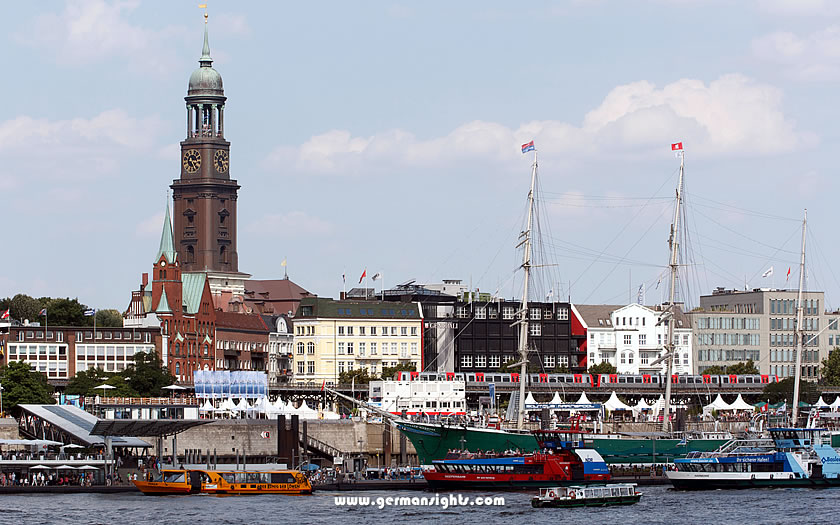
The 'Michel' towering over the Hamburg harbour
The church was heavily damaged during the Second World War but was rebuilt and restored in the post-war years.
The church tower is 132 meters (433 feet) tall and offers views over the city and harbour. Visitors can climb the 453 steps to the viewing platform or take an elevator.
The Elbphilharmonie is an iconic landmark in Hamburg. The stunning building sits on the Grasbrook peninsula of the Elbe River, part of the modern HafenCity development, and is one of the tallest inhabited buildings in Hamburg.
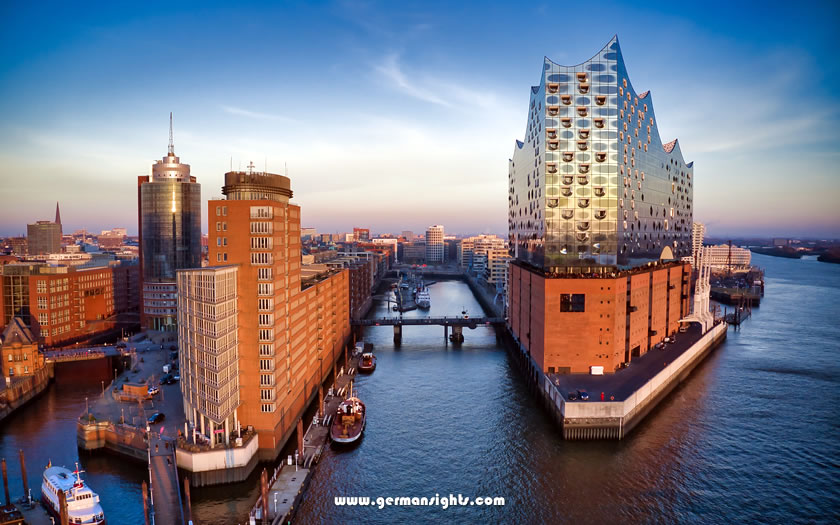
The iconic Elphilharmonie concert hall in Hamburg
The building attracted a fair amount of controversy during its construction, not least for the cost, but it now attracts classical music lovers and architecture buffs from around the world.
Visitors to the Elbphilharmonie can take in one of the performances - it is one of the largest and most acoustically advanced concert halls in the world - or, at times when it is not being used, take a guided tour around the building.
The plaza outside the building offers great views of the Elbe river and Hamburg harbour.
The Speicherstadt is a historic warehouse district in Hamburg that is listed as part of the UNESCO World Heritage.
It was built between 1883 and 1927 south of the Hamburg's old town on the former Elbe islands and in the poorer residential quarters of Kehrwieder and Wandrahm.
More than 20,000 former inhabitants of the areas were forced to make way for the new warehouses, which became part of Hamburg's free port.
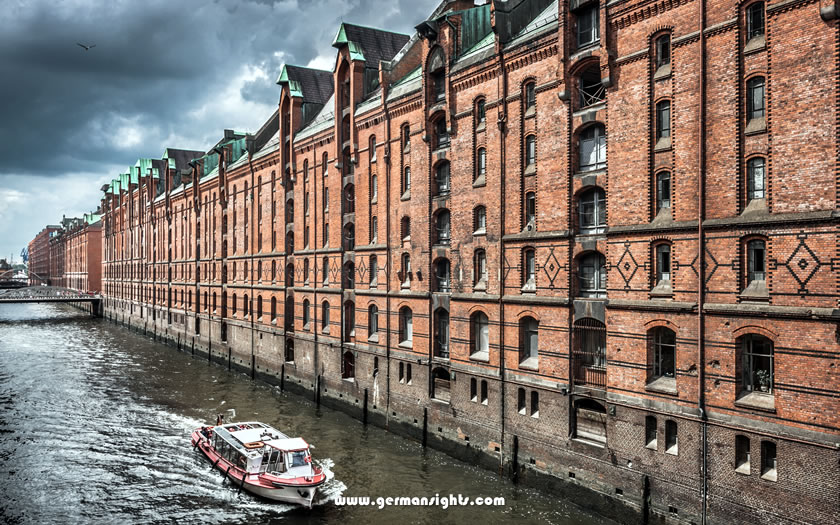
The Speicherstadt in Hamburg
Around half of the Speicherstadt was destroyed in the firestorms that followed the aerial bombing of Hamburg in World War II. Some of it was later rebuilt using the former architectural style, while part of it was devoted to the new Hanseatic Trade Centre.
The growth in container shipping led to the Speicherstadt being removed from the free port in the early 2000s - the free port was finally dissolved altogether in 2013 - and the Speicherstadt is now part of the redevelopment of the HafenCity area in the Hamburg-Mitte district.
👉 Discover more about the Speicherstadt on a guided walking tour
👉 Find out more about the Speicherstadt on this site
Hamburg Rathaus, the city hall, is the largest one of its kind in Germany. Since Hamburg is its own state it serves as the seat of the Hamburg Parliament and Senate.

Hamburg Rathaus and square
The building was constructed at the end of the 19th century in a Neo-Renaissance style. It has just under 650 rooms and guided tours are available of the building.
It stands on the Rathausmarkt square which is one of the main meeting points in Hamburg and the location of various activities, including one of the popular Christmas markets.
The Alster is actually both a river and a lake. The river section runs into Hamburg from the north. The lake part was originally created by a dam in the 13th century at what is now the Jungfernstieg.
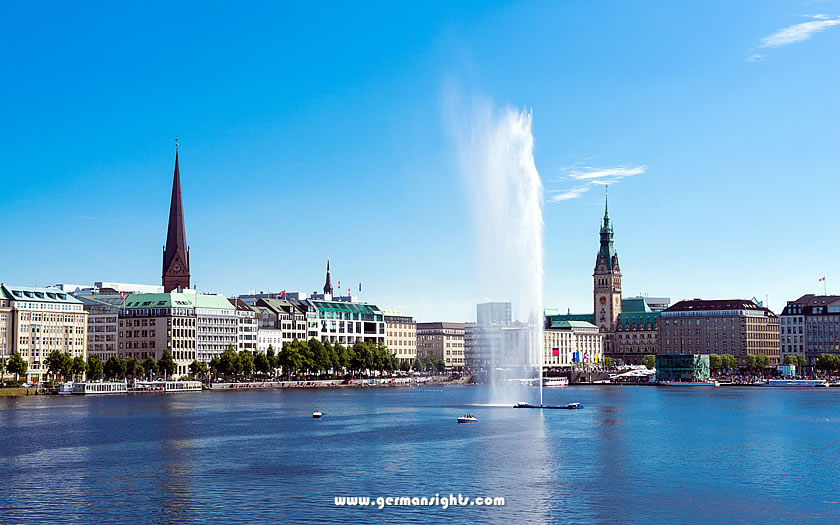
The Alster lake and Hamburg city centre
The lake is split into two distinct parts. The Binnenalster (the Inner Alster) is the part between the Jungfernstieg and the Kennedy bridge. From here the Kleine Alster and Alsterfleet run through the city into the Elbe river.
The Aussenalster (the Outer Alster) is the larger section to the north. This is a popular area for water sports and hikes.
Visitors can book various tours on the Alster, from a hop-on hop-off ferry journey to a sunset cruise.
👉 Book your cruise on the Alster
The St. Nikolai Memorial in Hamburg serves as a poignant reminder of the destruction brought about by World War II.
The memorial is located at the site of the former St. Nikolai Church, which was once the tallest building in Hamburg and one of the city's most important landmarks.
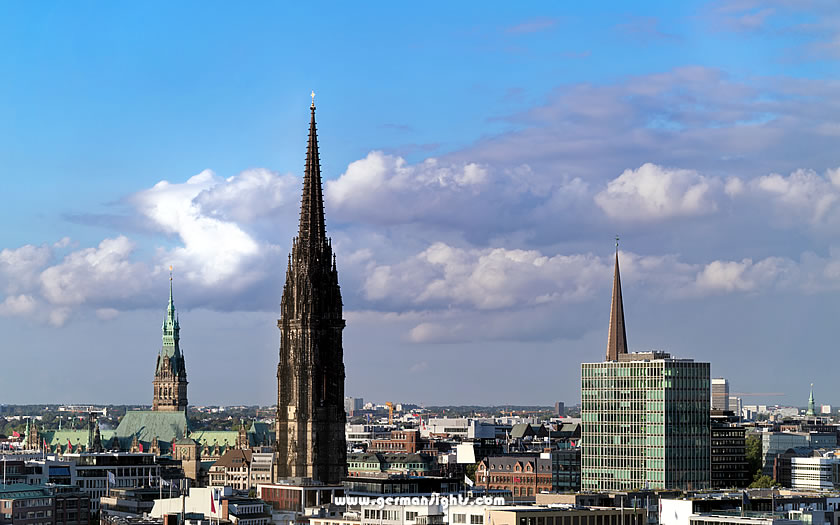
The St Nikolai memorial in Hamburg
The church was almost completely destroyed during Allied bombing raids in 1943, with only the tower and some outer walls remaining. At the end of the war, it was decided to preserve the ruins as a memorial against war and as a symbol of peace and reconciliation.
Visitors can now take an elevator to a viewing platform at the top of the 75.3-meter (247-foot) tower, which offers a panoramic view of the city.
The crypt beneath the church has been converted into a museum that documents the history of the church and the impact of the war on Hamburg. Exhibits include photographs, artifacts, and personal accounts from survivors.
The Chilehaus is a striking office building located in Hamburg, Germany that was built between 1922-1924. It is considered one of the finest examples of 1920s expressionist architecture.
It was designed by German architect Fritz Höger for the shipping magnate Henry B. Sloman, who made his fortune trading saltpeter from Chile (hence the name Chile House).

The striking architecture of the Chilehaus in Hamburg
The building has a very distinctive shape, with the walls meeting at sharp angles and forming a pointed tip on one side, resembling a ship's prow. This was intended to represent the power and importance of Hamburg's shipping industry.
It is constructed from dark brick, with the facade featuring intricate brick patterns. The top of the building has copper plating, adding to its unique appearance.
The Chilehaus has been a protected historic building since 1983. It was declared a UNESCO World Heritage Site in 2015, along with the nearby Kontorhaus district.
St. Pauli is a lively and edgy district in central Hamburg known for its nightlife.
The Reeperbahn, a street at the heart of St. Pauli, is lined with bars, nightclubs, and the city's red light district. While the area has a somewhat seedy reputation, it also offers some unique sights and experiences for visitors.
But St. Pauli isn't just about the more disreputable side of life. The local football team, FC St. Pauli is known for its alternative left-leaning culture and rabid fan base. They play at the Millerntor Stadium and spend most seasons in the German Second Division (2e. Bundesliga).

The St. Pauli Landungsbrücken
The district also extends down to the Elbe river and the St. Pauli Landungsbrücken. These are floating piers once used for steamships but which now serve as the base for ferry rides and boat tours around the harbour.
It's also the place to pick up a fish roll (see more about the local fish cuisine here) or explore the historic tunnels under the river.
👉 Take a guided cruise around Hamburg harbour on one of the tour boats
The fish market is a destination which comes to life once a week for a few hours. But during that time it is a raucous Hamburg attraction.
The Hamburg fish market is held in the Altona district down by the Elbe. It opens each Sunday at 05.00 and closes at 09.30 (opens at 07.00 during the winter) and has been a Hamburg institution since 1703.

The fish auction hall in Altona
One of the main attractions is watching (and hearing) the fish auction. Auctioneers hawk the catches of the day in a rapid staccato chant, a tradition that dates back centuries.
After shopping, visitors often head to one of the many riverside stands or restaurants for a Fischbrötchen (fish sandwich) and a beer or coffee. Musicians and bands add to the lively atmosphere with live performances.